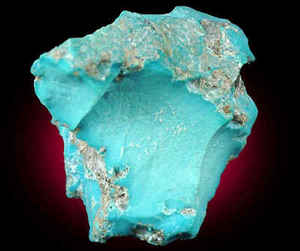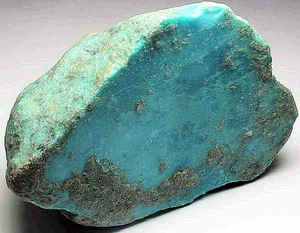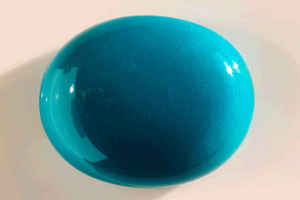

New Mexico Symbols
New Mexico State Gemstone or Gem
Turquoise

Adopted on March 23, 1967
The state legislature adopted turquoise as the state gem in 1967. Probably one of the most recognized semiprecious gemstones in existence, turquoise has been popular since prehistoric times. Beads dating back to 5000 BC have been found in Iraq. In New Mexico turquoise and ochre was mined near Santa Fe in pre-Columbian times.
Until the 1920's, New Mexico was the United States largest producer of turquoise. However, since then Arizona and Nevada has surpassed it in terms of both annual and total production.
Production of turquoise from deposits in the Cerrillos Hills, Santa Fe County; the Burro Mountains and Little Hachita Mountains, Grant County; the Jarilla Hills, Otero County; and the Guadelupe Mountains, Eddy County; can be traced to prehistoric Indians. Several different mines operate or have operated at each of the New Mexico locations mentioned, producing seam and nugget turquoise. Many of the more famous and higher-quality deposits are economically depleted. Turquoise from these deposits was as good as that from any deposit in the world and were the first to displace true Persian turquoise in the U.S. market. Color varied from light to dark green, greenish-blue, bluish-green, paler blue shades, and fine sky-blue. Much of the material was spiderwebbed with thin veinlets of limonite.
Currently, with the exception of byproduct material from copper mines, production of turquoise from deposits in New Mexico, for all practical purposes, has stopped. Turquoise still can be found in New Mexico, but production in any significant quantity is a question of economics and the determination of the individuals involved.
Turquoise: New Mexico State Gemstone or Gem

The name turquoise may have come from the word Turquie, French for Turkey, because of the early belief that the mineral came from that country (the turquoise most likely came from Alimersai Mountain in Persia (now Iran) or the Sinai Peninsula in Egypt, two of the world's oldest known turquoise mining areas.) Another possibility could be the name came from the French description of the gemstone, "pierre turquin" meaning dark blue stone.
Turquoise from New Mexico comes in various shades of blue, blue-green, green-blue, and green. Some of the turquoise may contain iron, if it does, its color is pale green to yellow-green to yellow. The material can be solid colored or spiderwebbed with either brown or black webbing; the spiderwebbing may occur in any of the different colors or shades. Some of the blue material is represented as the finest pure-blue turquoise produced. It can occur in thin veins or seams or as nodules, with single nodules reported as large as 150 pounds. The quality varies from hard solid material that takes a good polish, to soft porous material that can only be use as feed stock for treatment, enhancement, or stabilization processes.
History
In 1535, Alvar Nu?z Cabeza de Vaca made an extraordinary journey from eastern Texas through New Mexico to Sonora on the Pacific coast. Cabeza de Vaca and his companions were the first to note the use of turquoise among Native Americans. Hundreds of years before www.legis.state.nm.us Fossil Gem New Mexico Natural History Museum the Spanish explorers arrived, Native Americans were mining and fashioning ornaments out of this gemstone and the shell and coral from the California coast that they acquired in trading with other tribes.
Chemically, turquoise is a phosphate of aluminum carrying small quantities of copper and iron. Turquoise is the only phosphate that is considered a precious stone and is the most valuable nontransparent mineral in the jewelry trade.
The Navajo and Pueblo Indians of the Southwest call turquoise chalchihuitl, as did the ancient peoples of Mexico and Central America, who used the same word to describe jade or green turquoise. Turquoise set in silver is a big industry in New Mexico. Beautiful and authentic pieces may be purchased on reservations or at fashionable stores throughout the United States.
Turquoise has captivated man's imagination for centuries. When it came to the attention of man is unknown. We have archeological as well as literary references that pre date the Christian era by five millenia. The four bracelets of Queen Zar, found on her mummified arm, date to the second ruler of the Egypt's First Dynasty, approximately 5500 B.C. Although not specifically mentioned in the Bible, scholars believe that the robe worn by the high priest Aaron was adorned with turquoise. Aristotle, Pliny and others refer to stones that must have been turquoise. After the fourth or fifth century A.D., many writings appeared discussing the stone. Explorers such as Marco Polo took time to write about it.
DECEMBER Birthstone: Turquoise
The name turquoise, from the French expression Pierre tourques or Turkish stone, originated in the thirteenth century and describes one of the oldest known gemstones. Its name is believed to originate from the French phrase "pierre turquoise"meaning "Turkish stone"because turquoise was brought to Europe by Venetian merchants who first acquired it in Turkish bazaars. Turquoise varies in color from greenish blue, through robin's egg-blue, to sky blue shades and its transparency ranges from translucent to opaque. Turquoise is plentiful and is available in a wide range of sizes. It is most often used for beads, cabochons, carvings, and inlays. Although its popularity fluctuates in fashion, it is a perennial favorite in the American Southwest.
New Mexico Law
The law designating turquoise as the official New Mexico state gem is found in the New Mexico Statutes, Article 3, Section 12-4-4 G
Chapter 12 - Miscellaneous Public Affairs Matters
Article 3 - State Seal, Song and Symbols
Section 12-3-4 - State flower; state bird; state tree; state fish; state animal; state vegetables; state gem; state grass; state fossil; state cookie;
state insect; state question; state answer; state nickname; state butterfly; state reptile; state amphibian; stat
Universal Citation: NM Stat § 12-3-4 (2013)
12-3-4. State flower; state bird; state tree; state fish; state animal; state vegetables; state gem; state grass; state fossil; state cookie; state
insect; state question; state answer; state nickname; state butterfly; state reptile; state amphibian; state aircraft; state historic railroad; state
tie; state necklace. (2011)
A. The yucca flower is adopted as the official flower of New Mexico.
B. The chaparral bird, commonly called roadrunner, is adopted as the official bird of New Mexico.
C. The nut pine or pinon tree, scientifically known as Pinus edulis, is adopted as the official tree of New Mexico.
D. The native New Mexico cutthroat trout is adopted as the official fish of New Mexico.
E. The native New Mexico black bear is adopted as the official animal of New Mexico.
F. The chile, the Spanish adaptation of the chilli, and the pinto bean, commonly known as the frijol, are adopted as the official vegetables of New
Mexico.
G. The turquoise is adopted as the official gem of New Mexico.
H. The blue grama grass, scientifically known as Bouteloua gracillis, is adopted as the official grass of New Mexico.
I. The coelophysis is adopted as the official fossil of New Mexico.
J. The bizcochito is adopted as the official cookie of New Mexico.
K. The tarantula hawk wasp, scientifically known as Pepsis formosa, is adopted as the official insect of New Mexico.
L. "Red or green?" is adopted as the official question of New Mexico.
M. "Red and green or Christmas" is adopted as the official answer of New Mexico.
N. "The Land of Enchantment" is adopted as the official nickname of New Mexico.
O. The Sandia hairstreak is adopted as the official butterfly of New Mexico.
P. The New Mexico whiptail lizard, scientifically known as Cnemidophorus neomexicanus, is adopted as the official reptile of New Mexico.
Q. The New Mexico spadefoot toad, scientifically known as Spea multiplicata, is adopted as the official amphibian of New Mexico.
R. The hot air balloon is adopted as the official aircraft of New Mexico.
S. The Cumbres and Toltec scenic railroad is adopted as the official historic railroad of New Mexico.
T. The bolo tie is adopted as the official tie of New Mexico.
U. The Native American squash blossom necklace is adopted as the official necklace of New Mexico.
History: Laws 1927, ch. 102, § 1; C.S. 1929, § 129-101; 1941 Comp., § 3-1303; Laws 1949, ch. 142, § 1; 1953 Comp., § 4-14-3;
Laws 1955, ch. 245, § 1; 1963, ch. 2, § 1; 1965, ch. 20, § 1; 1967, ch. 51, § 1; 1967, ch. 118, § 1; 1973, ch. 95, §
1; 1981, ch. 123, § 1; 1989, ch. 8, § 1; 1989, ch. 154, § 1; 1999, ch. 266, § 1; 1999, ch. 271, § 1; 2003, ch. 182, §
1; 2005, ch. 4, § 1; 2005, ch. 254, § 1; 2007, ch. 10, § 1; 2007, ch. 179, § 1; 2011, ch. 52, § 1.
Minerals, & Gems

Gemstone, Minerals, Rocks





